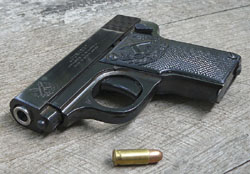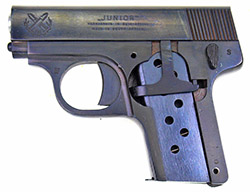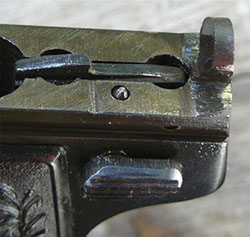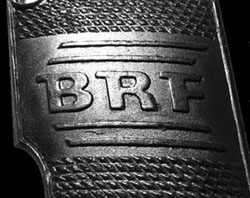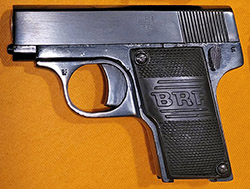 |
||||||||||||||||||||||||||||||||||||||||||||||||||||||||||||||||||||||||||||||||||||||||||||||||||||||||
|
The Pretoria Arms Factory by Ed Buffaloe
I found my 6.35mm PAF pistol at the gun show in Tulsa. I kept going back to the table to look at it because, at the time, I had never seen one before. The seller told me he had bought it in 1967 and had never fired it. I brought the gun home and began to research it but found virtually nothing. The Dictionary of Guns and Gunmakers says only: “Pretoria Arms Factory, Pretoria, Republic of South Africa. Maker of the .25 calibre Junior, or P.A.F. pocket automatic pistols.” That told me nothing more than I had already gleaned by reading the slide inscription on the gun and talking to the guy who sold it to me. A month later I was looking through J.B. Wood’s Troubleshooting Your Handgun, and there it was, a precious five paragraphs of information on the PAF. The PAF Junior was designed by P. Nagel, a Dutch immigrant to South Africa, and was made from 1954 to 1957. The striker fired unlocked breech design is almost identical to the Browning FN Model 1906 and Colt Model 1908 vest pocket pistols, minus the grip safety. The three barrel lugs on the Browning are reduced to one, much like the CZ models 1936 and 1945. The disconnector is a vertical projection from the trigger bar like the one on the Berettas of the early 1930s. The Junior is about the same length as the “Baby” Browning, but has a larger grip. The conventional magazine holds eight rounds and has eight viewing holes on the left side. J.B. Wood says the only original feature of the PAF is a small pin at the rear of the frame which is cammed upward by the manual safety to lock the slide. The early PAF pistols had raised fixed sights integral with the slide, at least through serial number A1500. At some point after that the sights were eliminated and the gun has only a sighting groove on the top of the slide. My impression in handling the gun is that the PAF is a bit awkward. It is very slim, but sits high in the hand. The magazine baseplate falls right in the middle of my ring finger, making the gun uncomfortable to grip tightly. The right side grip stock on my gun is cracked. The stocks are too thin overall, particularly at the corners where the screws go. The cracking seems to have been caused by shrinkage of the cheap plastic rather than rough handling. Replacement stocks are available from Triple-K. Stocks are known in both white or black plastic. Wood states that some of these guns may not have had adequate heat treating, as he has seen one in which the striker spring base and the lower projection at the front of the slide were deformed from having been shot extensively. He also said he had seen a magazine in which the thin sheet metal had split at the back. Wood also felt the pivot points for the trigger and sear were not well placed, indicating that the designer was likely inexperienced. My PAF had not been properly oiled and had started to rust on surfaces where the metal was not highly polished. This is particularly visible in the scan of the gun components. I disassembled the gun and oiled it thoroughly, but still have not managed to remove all the rust. While the gun seems reasonably well made externally, the interior machining is rather rough and there are sharp edges that catch threads from cotton patches and cleaning cloths. I ran an oiled patch through the barrel, which came out absolutely clean, indicating the guy may have told me the truth when he said he had never fired it. The inscription on the left side of the slide is in uppercase sans serif characters, and reads: “JUNIOR” The PAF logo, two crossed cartridges above the PAF monogram surrounded by a wreath, appears on both sides of the slide, as well as on each grip stock. The serial number is on the back of the grip frame. Barrels are marked 6.35 M.M., next to which is stamped a wildebeest head in an oval. Hogg & Weeks state that about 10,000 Juniors were made. Thus far, A10762 is the highest number I have recorded. Please write if you have a higher serial number.* Apparently there are a few PAF .32 prototypes in existence, but the .32 version was never a production gun. Some examples are marked “BRF” on the stocks instead of “PAF”, and a few are stamped “BRF” on the slide but retain PAF stocks. Some collectors have speculated that BRF stands for Bristol Firearms Company, which sold the PAF under their name in the U.S. However, a gentleman from South Africa has recently informed me that the remaining stock and tooling from the company was purchased by an employee whose name was Bertram Rudolph Freiling. The letters BRF are his initials. It has come to my attention that at least one BRF pistol has a cocking indicator, a small pin that protrudes from the rear of the gun when the striker is cocked, but I have not documented one myself. I would appreciate hearing from anyone with a gun like this. Field Stripping the PAF:
Note: These guns are sometimes difficult to disassemble and even more difficult to reassemble. The slide lock pin (mentioned in the fourth paragraph, above) should be pressed down by the slide when you push it forward, but can get stuck if not properly lubricated. * I’ve had responses from individuals owning serial numbers A0231, A0322, A0732, A1351, A2495, A3689 (w/ white grips), A5150, A5125 (w/ BRF grips), A5343, A5431, A5515, A5560 (w/ BRF grips), A5660 (BRF), A6109, A6714, A6956, A7178, A7268, A7270, A7389, A7660, A8144, A8626, A8709, A8826 (BRF), A8840, A9388, A10442, and 10762. |
||||||||||||||||||||||||||||||||||||||||||||||||||||||||||||||||||||||||||||||||||||||||||||||||||||||||
|
Copyright 2008-2024 by Ed Buffaloe. All rights reserved. |
||||||||||||||||||||||||||||||||||||||||||||||||||||||||||||||||||||||||||||||||||||||||||||||||||||||||
|
||||||||||||||||||||||||||||||||||||||||||||||||||||||||||||||||||||||||||||||||||||||||||||||||||||||||
|
|
||||||||||||||||||||||||||||||||||||||||||||||||||||||||||||||||||||||||||||||||||||||||||||||||||||||||
